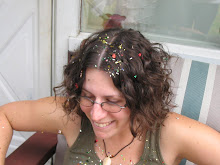There was a moment the other day when I felt discouraged. I questioned whether this was the right place to come for my dissertation. I think it was really just a slip in confidence. Luckily, it was fleeting. That afternoon we (actually, Ciprian) succeeded in making the GPS data collection device communicate with one of the computers. We were then able to pinpoint some probable feeding sites for one of the male leopards. Once we acquired the data points we went out to find bones. We visited three out of four sites before the sun went down and found recent bones at one of them. The other two were not as productive, but that is bound to happen now and then and we were short on search time. In addition, some of the points were from over three weeks ago.
If I come back here in a year for my dissertation research, I could track at least one leopard, if not several, on a regular basis, increasing my chances of finding prey bones and possibly even finding a baboon carcass. However, I have come to the conclusion that even if I don't find baboons, and I may not, it will be an interesting, worthwhile, and very productive actualistic study that would contribute to our understanding of leopard feeding behaviors and the marks they leave on bones. I really cannot ask for more. The tricky part will be figuring out what are leopard tooth marks and what comes from hyaenas and lions. Hyaenas in particular will snag the remains of leopard meals and crunch them to splintery bits. How do I know what is caused by leopard teeth? My potential solution to this, apart from following them like a hawk, is camera traps. With those two methods, hopefully I can do one or two things: see which parts the leopards are eating or steal carcasses away before hyaenas get a chance to make permanent alterations. It's hard to know what is the best solution. Probably I will try a little of both and figure out which is best in practice. Because I must tell you, snatching a carcass is daunting. You may not know the leopard is standing guard nearby.
Baboons live near camp, and it is possible that I will at least find a scavenged carcass or two. They are chacma baboons, larger than all other baboon subspecies (or species, depending on who you ask). They come around camp and try to get into things, like any good primate. I watched them for awhile from the dining area but then one or two individuals would get a little too bold and I'd have to chase them away. A couple of times, Ciprian helped by banging pots and pans together and finally by chasing them with the gun. He didn't shoot them of course.
Our last full day in Botswana we went back to the giraffe carcass that we'd found that first full day. It was pretty well consumed at least in terms of soft tissue. Three out of four limbs were gone. One hind limb had been completely severed in half at the midshaft of the femur. Think of your thigh bone being broken clean in two at the midpoint. Now try that with a giraffe femur. The only thing that can do that is a spotted hyaena. Impressive. The carcass had been broken into two major portions somewhere along the spine so that the hindquarters were dragged about seven meters from the forequarters. Probably this was the result of multiple individuals feeding at the same time. One hyaena says to the other, "hey man, I called it first" and proceeds to haul it to the nearest acacia bush just for good measure. I suspect the missing limbs were reduced to pieces somewhere within a kilometer radius or so. Finding the bones would probably be almost impossible.
The take home message here is that I think I can work in Botswana. In fact, I think that it will be a very good fit. It will not be cheap, but that is another story, one I will take up with various funding organizations.
Next stop...Johannesburg.
Subscribe to:
Post Comments (Atom)




No comments:
Post a Comment